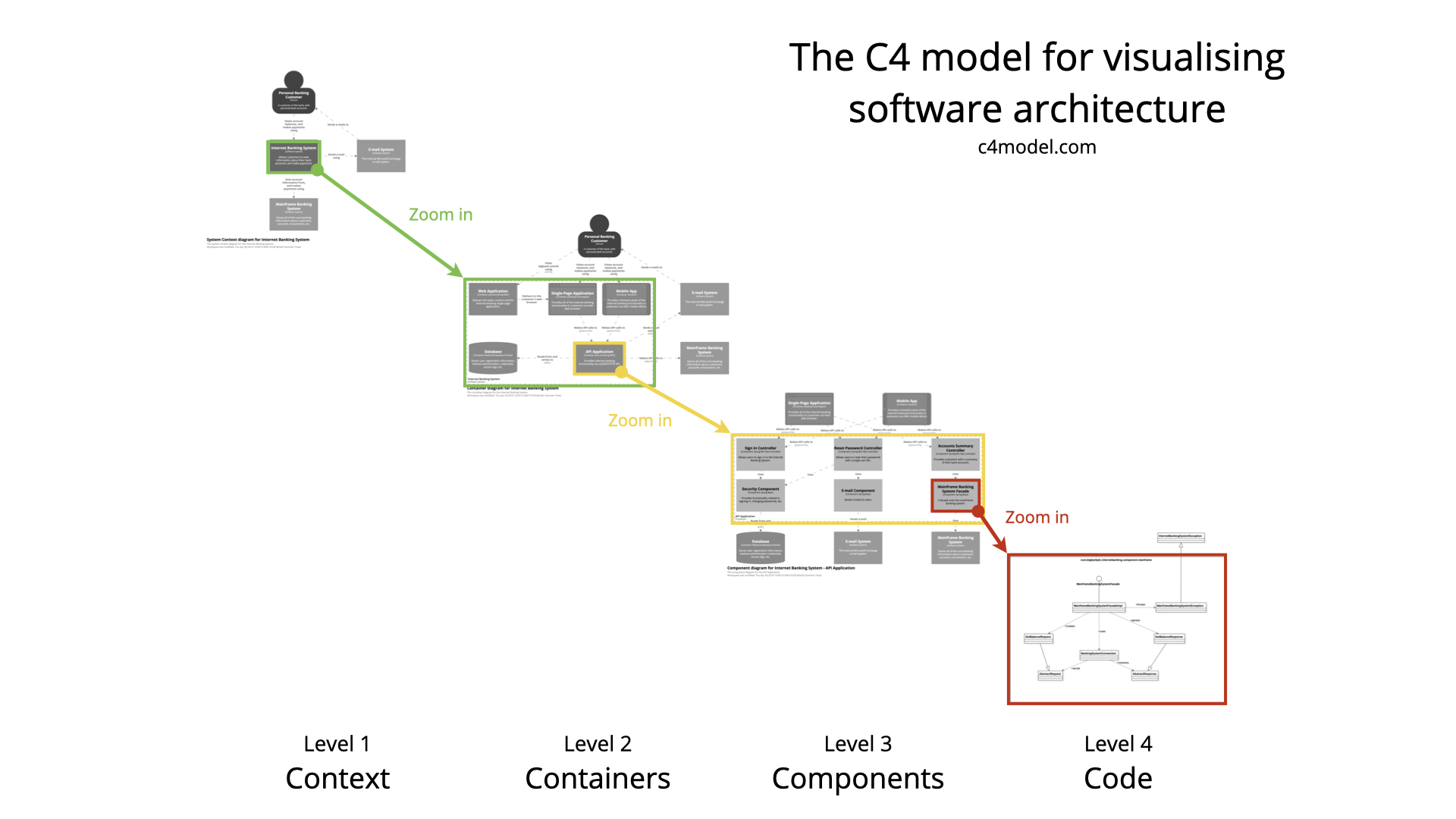Harnessing the Power of C4 Model for Knowledge Management in Organizations: A Comprehensive Guide
Published:
Preface
In today’s fast-paced business environment, effective knowledge management is crucial for organizations to stay ahead of the curve. One approach that has gained traction in recent years is the C4 Model, a visual notation technique for software architecture. In this blog post, we will explore the C4 Model, its components, and how it can be applied to manage knowledge within an organization. By the end of this comprehensive guide, you will have a better understanding of the C4 Model and its potential use cases in knowledge management.
What is the C4 Model?
The C4 Model, developed by Simon Brown, is a hierarchical approach to visualizing software architecture. It consists of four levels of abstraction, each focusing on a different aspect of the system:
Context: This level provides a high-level view of the system, its users, and external dependencies. It helps stakeholders understand the system’s purpose and scope.
Containers: This level zooms in on the system’s components, such as web applications, databases, and microservices. It shows how these components interact and communicate with each other.
Components: This level dives deeper into the containers, breaking them down into smaller, more manageable parts. It highlights the relationships between these parts and their responsibilities.
Code: The final level focuses on the implementation details, such as classes, interfaces, and functions. It provides a granular view of the system’s inner workings.
Using the C4 Model for Knowledge Management
Now that we have a basic understanding of the C4 Model let’s explore how it can be applied to knowledge management within an organization.
Context: Defining the Knowledge Landscape
The first step in using the C4 Model for knowledge management is to create a context diagram that outlines the organization’s knowledge landscape. This includes identifying the various sources of knowledge, such as documents, databases, and human expertise, as well as the stakeholders who interact with this knowledge, such as employees, customers, and partners.
By visualizing the knowledge landscape, organizations can gain a better understanding of the flow of information and identify potential bottlenecks or gaps in knowledge sharing. This high-level view also helps stakeholders align their goals and expectations, ensuring that everyone is on the same page.
To create a context diagram, organizations can use tools like draw.io, Lucidchart, or Microsoft Visio. These tools allow users to create visual representations of the knowledge landscape, including the various sources of knowledge and the stakeholders who interact with them.
Containers: Organizing Knowledge Repositories
The next step is to create a container diagram that represents the organization’s knowledge repositories. These repositories can include wikis, document management systems, intranets, and other tools used to store and share information.
The container diagram should illustrate how these repositories interact and communicate with each other, as well as their relationships with the stakeholders identified in the context diagram. This helps organizations identify redundancies, streamline their knowledge management processes, and ensure that information is easily accessible to those who need it.
When creating a container diagram, organizations should consider the following factors:
The types of knowledge repositories used within the organization
The relationships between these repositories (e.g., how they share information or collaborate)
The access controls and permissions for each repository (e.g., who can view, edit, or delete information)
Components: Breaking Down Knowledge Assets
With the knowledge repositories in place, organizations can now focus on breaking down their knowledge assets into smaller, more manageable components. This can include categorizing documents, tagging content with relevant metadata, and creating knowledge maps that outline the relationships between different pieces of information.
By breaking down knowledge assets into components, organizations can make it easier for employees to find and access the information they need, reducing the time spent searching for answers and increasing overall productivity.
To break down knowledge assets into components, organizations can use techniques such as:
Taxonomies: Create a hierarchical classification system for organizing documents and other knowledge assets based on their content, purpose, or other relevant criteria.
Metadata: Add descriptive information to knowledge assets, such as keywords, categories, or author names, to make them more easily discoverable.
Knowledge maps: Develop visual representations of the relationships between different pieces of information, helping employees understand how different knowledge assets are connected.
Code: Implementing Knowledge Management Best Practices
The final step in applying the C4 Model to knowledge management is to implement best practices at the code level. This can include adopting standardized naming conventions, creating templates for common document types, and implementing version control systems to track changes to knowledge assets.
By focusing on the details at the code level, organizations can ensure that their knowledge management processes are consistent, efficient, and easy to maintain.
Some best practices to consider when implementing knowledge management at the code level include:
Standardized naming conventions: Establish a consistent naming scheme for documents and other knowledge assets, making it easier for employees to locate and identify relevant information.
Templates: Create templates for common document types, such as meeting minutes, project plans, or technical specifications, to ensure consistency and streamline the creation process.
Version control: Implement version control systems, such as Git or Subversion, to track changes to knowledge assets and maintain a history of revisions.
Conclusion
The C4 Model, while originally designed for software architecture, can be a powerful tool for managing knowledge within an organization. By applying the principles of the C4 Model to knowledge management, organizations can create a clear, structured, and efficient approach to storing, sharing, and accessing information.
By defining the knowledge landscape, organizing repositories, breaking down assets, and implementing best practices, organizations can harness the power of the C4 Model to improve their knowledge management processes and ultimately drive better decision-making, innovation, and growth.

photo from c4model.com

Leave a Comment